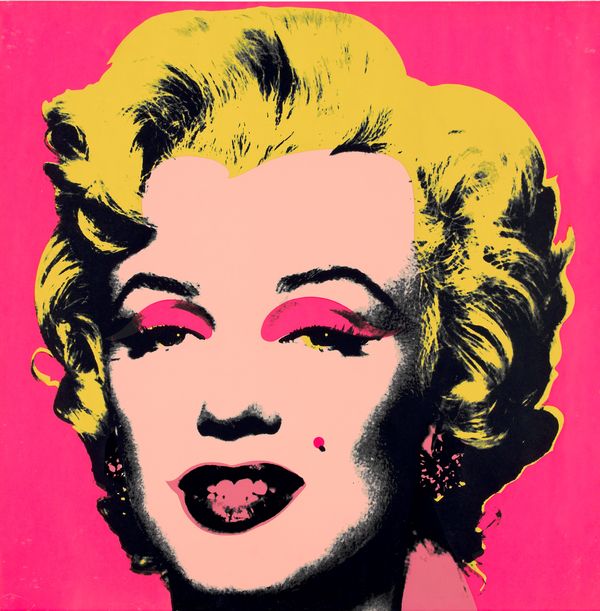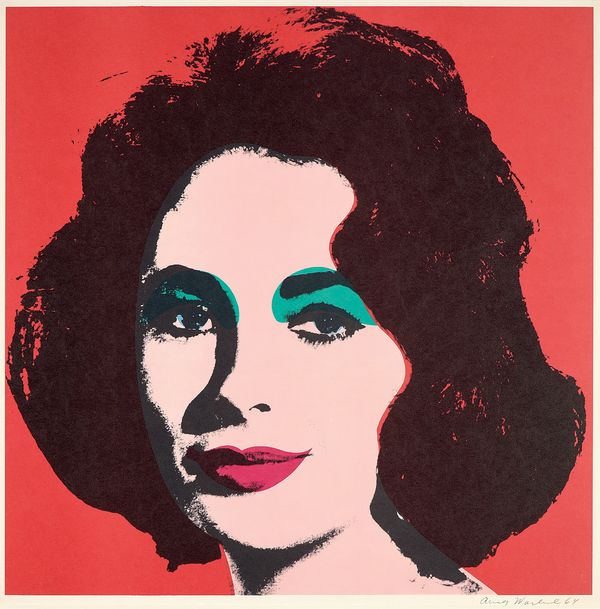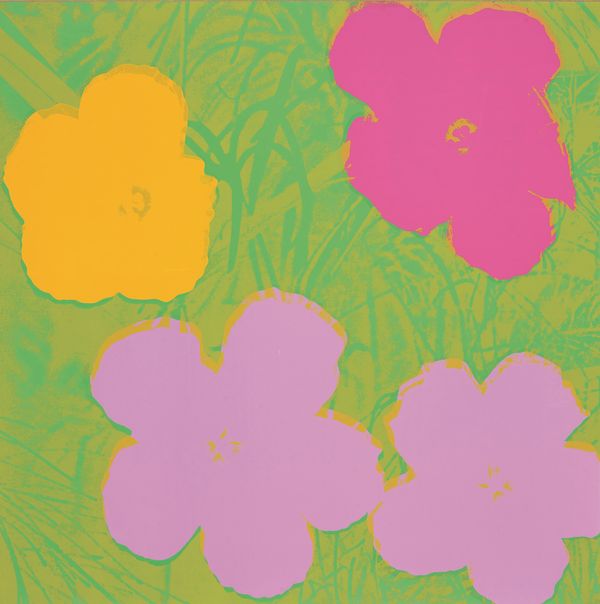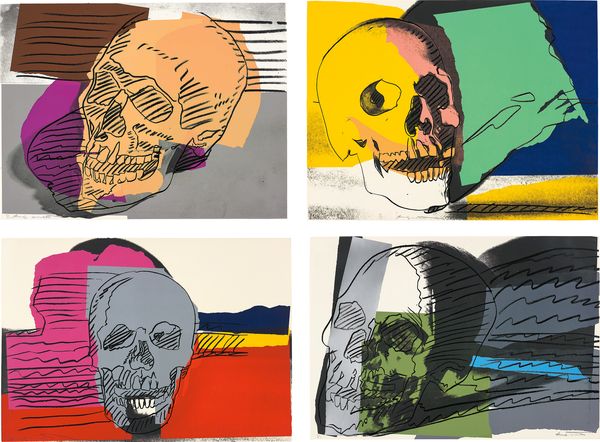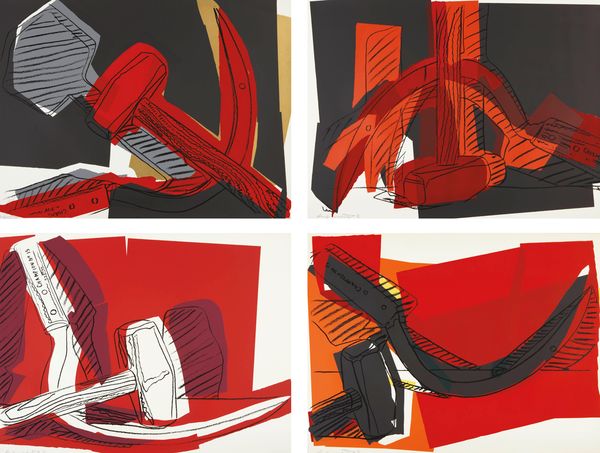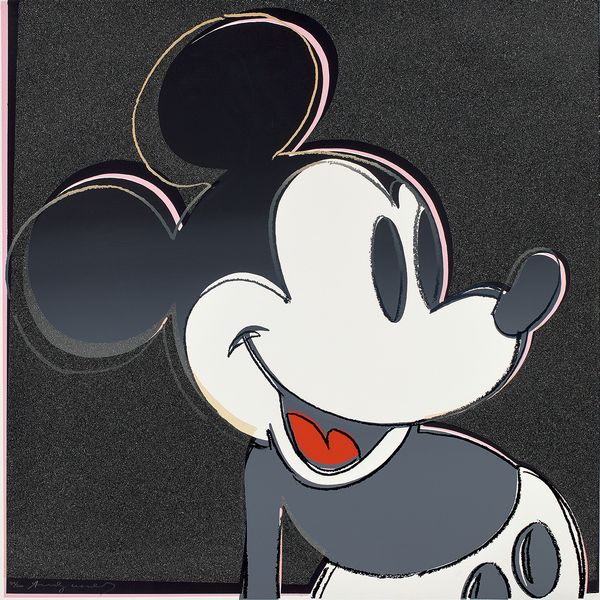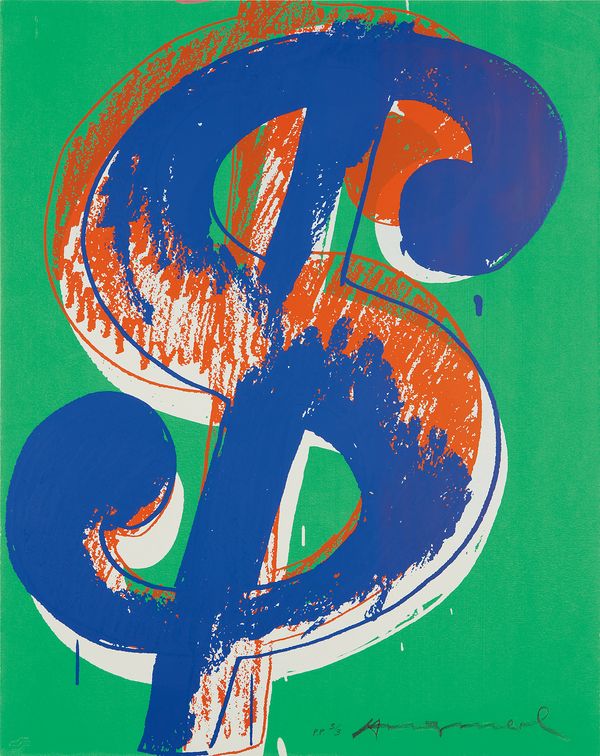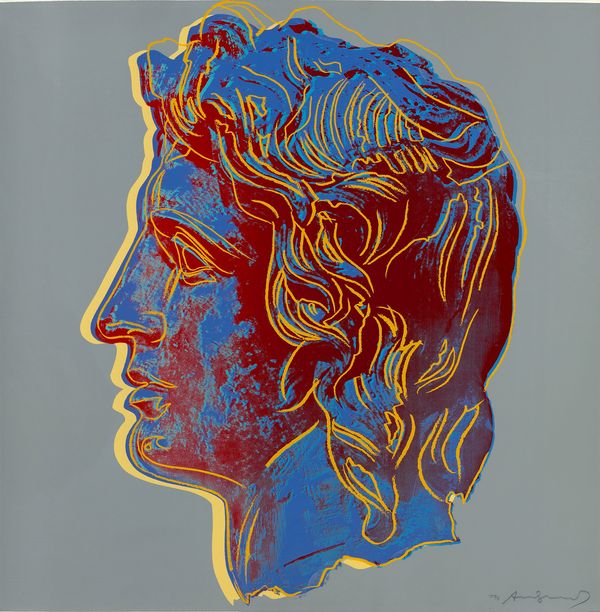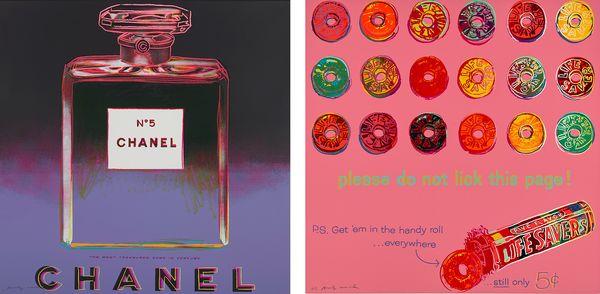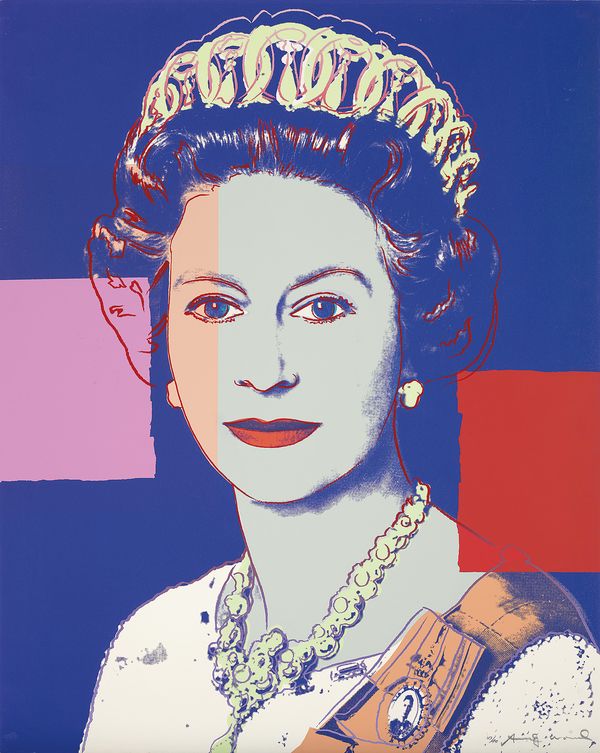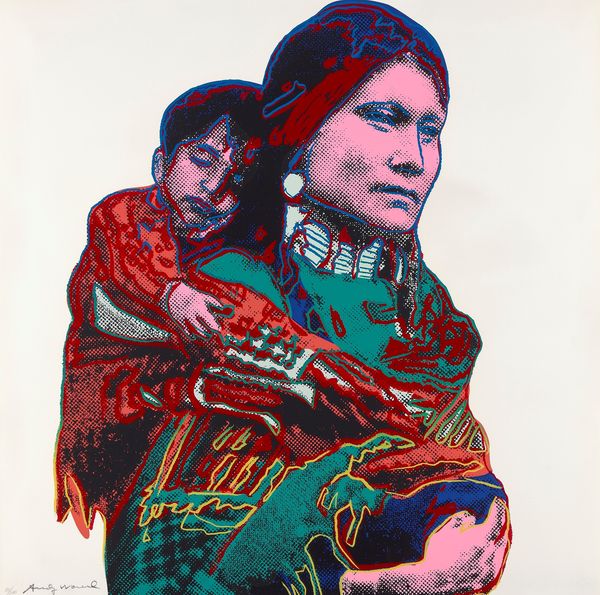Andy Warhol Three works: (i-iii) Self-Portrait, 1986. Sold in New York for $106,250.
A fascination with celebrity, consumerism and pop-culture propelled Andy Warhol to American icon status. Obsessed with fame, glamour and tragedy, Warhol created a vast body of works including paintings and screenprints, unified by his use of repeated imagery and exploitation of commercial, colorful, flat surfaces.
Raised by Slovakian working-class parents, in Pittsburgh, Pennsylvania, Warhol studied Pictorial Design at the Carnegie Institute, before moving to New York City in 1949. For a decade Warhol worked in commercial illustration, developing his skill of transforming imagery from his surrounding American culture. In a time of immense political and social change, he soon found the best realization of his ideas in his work as a fine artist. Warhol understood that to create an enduring image, he had to reduce and condense a likeness into an instantly recognizable motif. For this purpose, he embraced silk screening as his trademark technique from the 1960s onward. Responding to the ever-growing machine-made world, silkscreen allowed the removal of the artist’s hand to "paint like a machine." The result was seemingly massed produced images, similar to the commercial products of their contents.
A lifetime filled with capturing the fabrication of fame, immortalization of icons, and critique of consumer culture created a body of work now instantly familiar. Perhaps Warhol was able to predict the future, understanding a global obsession with fame that would lead to the rise of reality television and social media. Embracing his words, Phillips focuses on 15 of the artist’s most memorable prints from past and upcoming sales.
1.
Andy Warhol Marilyn, 1967. Upcoming in New York, 23 July 2020.
Warhol’s first major print project at the Factory was that of Marilyn Monroe in the Marilyn Diptych (1962). Marilyn’s untimely death combined with her mass fame formed an ideal subject for the artist who could address both tragedy and glamour with her image. Shortly after her death, Warhol started depicting Marilyn, creating more than twenty-six silk-screened paintings in the following four months. The still taken from the 1953 film Niagara has now become one of his most iconic motifs, perpetuated and reinforced by his portfolio of ten screenprints in varying colorways produced in 1967.
2.
Andy Warhol Liz, 1964. Sold in New York for $81,250.
At the height of her career and hospitalization for pneumonia, Warhol created this portrait of Liz Taylor from a publicity still taken from Taylor’s 1960s film Butterfield 8. Warhol said "I started those [pictures of Elizabeth Taylor] a long time ago, when she was so sick and everyone said she was going to die….Now I’m doing them all over, putting bright colours on her lips and eyes."
3.
Andy Warhol Tomato-Beef Noodle-O's, from Campbell's Soup II, 1969. Upcoming in London, 10 September 2020.
Warhol is perhaps best known for his Campbell’s soup works. In December 1961 the artist supposedly paid the interior decorator Muriel Latow $50 for the idea to use this image. Latow had said that Warhol should choose a subject "that everybody sees every day, that everybody recognizes …like a can of soup." The artist went on the use this imagery throughout his career. Tomato soup was the first flavor that Campbell’s released - it became the preeminent emblem of post-war consumerism and ubiquitous branding.
4.
Andy Warhol Flowers, 1970. Sold Online for £22,500.
Responding to the linear and all-over approach of then-fashionable modernist painting, Warhol transformed a photograph of Hibiscus blossoms from a 1964 issue of Modern Photography from the ordinary to the grand with decorative technicolor. In their debut at Leo Castelli’s gallery later that same year, Warhol covered the gallery walls entirely forming a wall-to-wall garden. Depicting their fleeting moments of bloom, the artist captured the fading beauty and fragility of these buds just as he did of his favorite film stars.
5.
Andy Warhol Mao, 1972. Sold in New York for $60,000.
In 1971 Warhol said "I have been reading so much about China. They’re so nutty. They don’t believe in creativity. The only picture they ever have is of Mao Zedong. It’s great. It looks like a silkscreen." The following year when Nixon made his historic state visit to China, Life magazine wrote that Mao was the most famous person in the world at the time. This mass-ideology Maoism instantly attracted Warhol. The artist thus took a portrait of the communist leader from his famous Little Red Book: The Thoughts of Chairman Mao for this series. The screenprints multiplicity is reminiscent of the mass-produced communist propaganda posters, which were widely displayed in China under Mao’s rule, but their coloring presents an air of kitsch Western fashion.
6.
Andy Warhol Skulls, 1976. Sold in London for £150,000.
Death, and the fear of it, preoccupied Warhol after his near-fatal shooting by Valerie Solanas in 1968. Warhol's Skulls call back to the Vanities allegory, drawing attention to mortality through the use of memento mori, in a time concentrated with growing anxiety over the escalating threats of nuclear war and ecological disasters. The portfolio of four Skulls was based on black and white photography taken by Warhol’s studio assistant Ronnie Cutrone. Warhol had found the object in a Parisian antique shop and instructed Cutrone to shoot the skull with varying light effects to dramatically accentuate the angles and recesses of the surface.
7.
Andy Warhol Hammer and Sickle, 1977. Upcoming in New York, 23 July 2020.
Engaging with the Communist symbol and the colors of Soviet propaganda, Warhol demonstrates his unique ability to raise historical and social issues with a striking reduction of image. For this series, he dismantled the components of the Communist icon, meant to symbolize unity, which were then photographed by his assistant Ronnie Cutrone. Like the Skulls, Hammer and Sickle could be considered a memento mori and reminder of the horrors of war and dictatorships. By using the hammer and sickle as a subject, Warhol compared images of propaganda to objects simply made to sell, simultaneously mocking both consumerism and communism.
8.
Andy Warhol Mickey Mouse, from Myths, 1981. Sold in New York for $137,500.
"At 4:00 the Walt Disney film crew came and shot me in front of my Shoes and my Walt Disney drawings. They asked me who my favorite Disney character was and I said 'Minnie Mouse, because she can get me close to Mickey.’’’
The Myths portfolio captures the iconic fictional characters of American pop culture. From hero to villain, Superman to The Witch, the artist represented fantasy, hopes, dreams and fears.
9.
Andy Warhol $ (1), 1982. Sold in New York for $60,000.
"I like money on the wall. Say you were going to buy a $200,000 painting. I think you should take that money, tie it up, and hang it on the wall. Then when someone visited you the first thing they would see is the money on the wall."
Born into Depression-era Pittsburgh, Warhol had a lifelong fascination with money. The Dollar Signs are among Warhol’s essential images, bluntly printing the sign for money as the sign for art. While Warhol anticipated the money-mad decade of the ’80s, the pertinence of this symbol is even more alive today in the globalized consumer world.
10.
Andy Warhol Alexander the Great, 1982. Upcoming in New York, 23 July 2020.
The late 1970s and early 1980s was a pivotal time for Warhol, forming a period of self-reflection that pushed him in new directions both critically and aesthetically. It was then that the pioneering appropriator turned to his own output and that of previous artists for new creative ideas. Warhol’s first foray into art historical subject matter was in 1963 when the Mona Lisa traveled to New York and Warhol created Thirty are Better Than One. Returning to art history Warhol formed his Details of Renaissance Paintings series, After Munch series and Saint Apollonia. The only series in which Warhol used Classicism as a subject was the profile of Alexander the Great. Based on a Hellenistic bronze bust, the Macedonian conqueror fulfills both celebrity and historical themes. As a symbol of Greek might, Alexander’s familiar image presents the immortality created through portraiture.
11.
Andy Warhol Chanel and Life Savers from Ads, 1985. Upcoming in London, 10 September 2020 and New York, 23 July 2020, respectively.
The ten prints in Ads were each based on popular advertising campaigns and logos of the mid-20th century, integral parts of American culture. While blatantly recognizing the commercial nature of society, the set elevated the original campaigns to the status of "art," while simultaneously serving as a form of advertising for Warhol's own work. By combining the signs and symbols of mass media, the artist could integrate both high and low cultural references - Chanel No. 5 formed a quintessential image of female glamour while Life Savers represented childhood innocence with its depiction of the well-known brand of ring-shaped candy.
12.
Andy Warhol Queen Elizabeth II of the United Kingdom, from Reigning Queens, 1985. Sold in London for £93,750.
Social hierarchy is at the fore in Warhol's Reigning Queens series. Depicting upper-class royalty in a contemporary aesthetic, the Queen is transformed into the modern celebrity Warhol imagined her to be. One of only four reigning queens in the world at the time of making, Queen Elizabeth’s photograph was taken from her 1977 Silver Jubilee portrait. The photograph has become one of the most recognizable images of the century and with it one of Warhol’s most iconic works.
13.
Andy Warhol Mother and Child, from Cowboys and Indians, 1986. Upcoming in New York, 23 July 2020.
In one of the last series Warhol produced, the artist interspersed historical figures with representative motifs of the past. The fantasy created in Cowboys and Indians of the American west suggests the contrived way in which media can affect an understanding of history. Warhol visited the National Museum of the American Indian to photograph a Plains Indian Shield, Northwestern Coast mask, and Kachina dolls, to combine with the familiar faces romanticized in novels and films such as Teddy Roosevelt and John Wayne.
14.
Andy Warhol Moonwalk, 1987. Sold in New York for $300,000.
Moonwalk prints were among the last works executed by the artist before his untimely death. Celebrating the 50th anniversary of the first moonwalk last year, the event has resurfaced in the public’s mind as one of the most defining moments of the modern era. The prints were to be part of a portfolio entitled TV that would show important images from the history of television, such as Martin Luther King Jr.’s "I Have a Dream" speech. Warhol combined two photographs of Buzz Aldrin and the flag, taken by Neil Armstrong for NASA, to create the composition for the pair of works.
15.
Andy Warhol Red Lenin, 1987. Sold in New York for $106,250.
As a conceptual successor to the artist’s earlier Hammer and Sickle works and Mao series of the previous decade, Lenin highlights Warhol’s fascination with the boundary between power and celebrity. Created for Bernd Klüser's exhibition Lenin by Warhol, the edition was published posthumously as one of 7 editions printed in the year of Warhol’s death. Lenin’s instantly recognizable face is distinguished by colors with specific symbolic properties. The original photograph used was discovered by Bernd Klüser in Italy in 1985. Originally taken in 1897, the image had started life as a group photograph but was modified in 1948 to remove those figures surrounding Lenin who had become opponents to Stalin. Warhol likely recognized the potential of this image with its history altered by fabrication.

